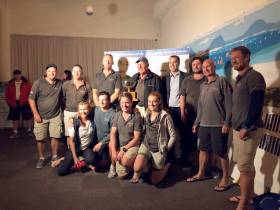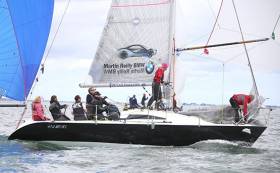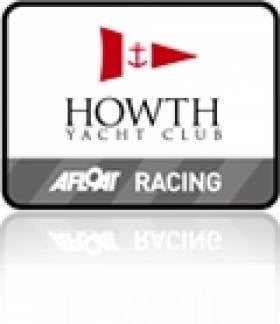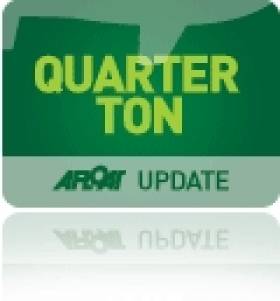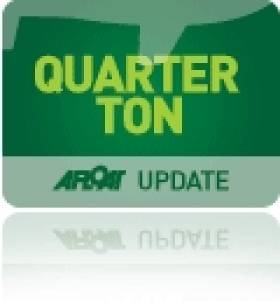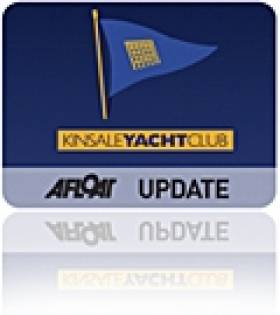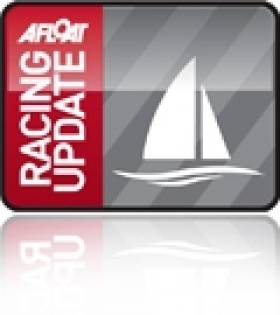Displaying items by tag: Quarter Tonners
Cork Harbour's Class Three continues to strengthen for the 2022 season with the arrival of three more good Quarter Tonners in the last two months.
Royal Cork's Winter League provided a glimpse of the latest moves into the club cruiser class that is providing 'great, great racing'.
Overall, the fleet includes some authentic classic designs, including an Albin Express, various Quarter Tonners, a Bolero, vintage J24s an HB31 and a Trapper 250.
Panic has just arrived from Northern Ireland, Illegal came from Cowes as Afloat reported previously and Anchor Challenge, a championship-winning boat (that has had three previous Cork owners) returns to the harbour for 2022. The last owner was Paul Gibbons who won the 2016 IRC Europeans held at Cork Week.
"The fleet includes some authentic classics, including an Albin Express, various Quarter Tonners, a Bolero, vintage J24s an HB31 and a Trapper 250"
What's the attraction of this size of cruiser? Most likely, it is the opportunity to sail with a small crew, often made up of just family and friends. And the fact that it is easily towed and provides cruiser racing on a budget is also a big factor, say insiders.
West Cork’s Mia Connolly In Full Sail With TP52 Crew Just Months After Move Down Under
A young Irish sailor is making her mark Down Under after swapping the shores of Skibbereen for the bright lights of Sydney.
Self-described “home bird” Mia Connolly had only spent a week outside of Ireland before upping sticks for Australia six months ago.
But she’s since put her years of experience as a pitman and trimmer — both in student yachting and later on such vessels as the J92 Jostler and Royal Irish Quarter-Tonners Cri Cri and Enigma — into a new challenge, crewing Gordon Ketelbey’s TP52, Zen.
Mia set off from Ireland last November with the dream of “that Sydney Harbour dream life”, including witnessing the Sydney to Hobart Race with her own eyes.
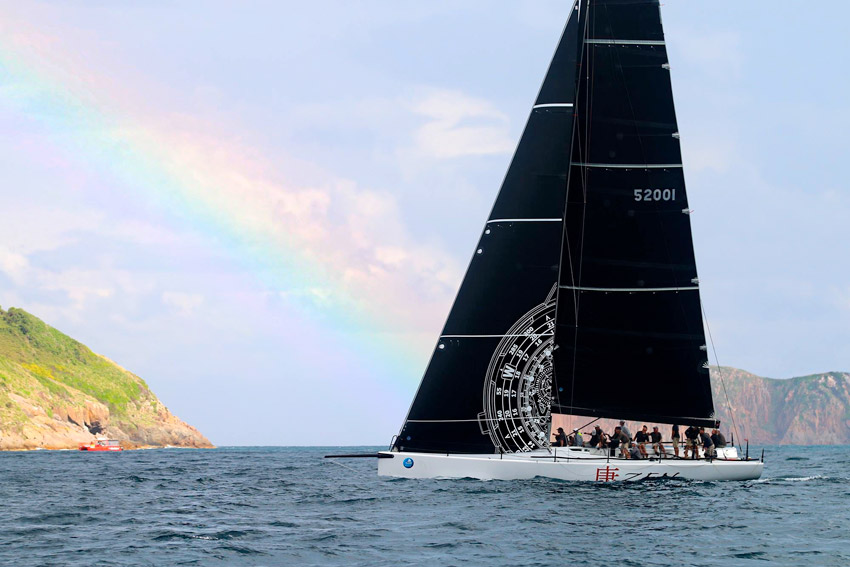 Gordon Ketelbey’s TP52, Zen
Gordon Ketelbey’s TP52, Zen
Yet within just a few short months she’s become a big race winner herself, assisting with the bow as part of the crew that took the IRC Division 1 title in the 2019 Garmin NSW IRC Championship last week.
That result in the Sail Port Stephens regatta came after victory in the Sydney Harbour Regatta State Championships, on the same waters she’d dreamed of watching others race this time year ago.
Mia also crews Ketelbey’s Farr 40, also named Zen, which just took part in its class national and state championships.
Such achievements don’t seem so surprising from someone who grew up in a leisurely sailing family, where roundings of Fastnet Rock were a regular feature of her childhood and Cape Clear Island “felt like a second home”.
Mia tells Afloat.ie: “It is now coming up to my six months here in Sydney and my journey in getting this far has no doubt been a challenge, but I guess dedication has no limits and I’m looking forward to seeing how the future unfolds.”
Irish Half tonners and Quarter Tonners are shaping up for a full–on season in 2016. Dave Cullen's old Half Tonner King One has reportedly just finished a big refit under new Howth owners which means Cullen's new steed Checkmate, Harmony, Big Picture and now King One are all tricked up and heading for the Half Ton Cup in Falmouth in August.
There is a lot of activity too in Dublin Bay Quarter Ton circles with refits and DBSC boats heading for the Quarter Ton Cup along with Paul Gibbons Anchor Challenge from Cork too.
Howth Yacht Club Launches Sportsboat Cup for 1720s, SB20s, Quarter Tonners, RS Elites, Dragons & J Boat Classes
#hyc – A Sportsboat Cup for Irish keelboat classes to be held around Midsummers day and tailored especially for 1720s, SB20s, Quarter Tonners, J24s, RS Elites, Dragons, J80s and J70s, is to be staged for the first time at Howth Yacht Club in north Dublin from 20th - 22nd June 2014.
At this multiclass event each of the sportsboat classes will be given their own start, results and prizes.
The event will incorporate the 1720 European championships as part of the event and there is an expectation of visiting UK and continental crews too.
Racing will be one design with the exception of the quarter tonners and mixed class who will race under IRC. Class rules will apply where applicable.
HYC says any other sportsboat type that has an IRC cert will also be accommodated in a mixed sportsboat fleet.
Howth is using the event to champion its sailing facilities both on the water and ashore at the 'bustling fishing village' venue that is also close to Dublin airport.
The largest club in the country has two cranes, a 300–berth marina, sizeable hardstanding, a large club house with bar, terrace and dining facilities not to mention secure changing and showering facilities
HYC is ideally placed to host this Sportsboat Cup. Car parking, craning, berthing and trailer storage are all included in the entry fee and racing will be organised by top National and International Race Officers.
With no racing starting before 12 each day there will be ample time to freshen up in the morning after the great social that is planned for each evening.
Online Entry available by clicking the HYC advert at the top of the Afloat homepage.
Kenefick Sucessfully Defends Quarter Ton Crown in Cowes
#quarterton – In the Corinthian Division of the Quarter Ton Cup for all-amateur crews Afloat's Irish Sailor of the Year George Kenefick sailed Tiger, the 1989 Fauroux design he owns jointly with his father Neil, to victory ahead of Sergeant Pepper, Richard and Anne Thomas's Bolero, which was designed by Richard's father David.
Third place went to Paul Kelsey's Runaway Bus, a 1977 Whiting design, with Love In A Mist, a 1974 Waarschip owned by Eric and Philip Williams - the oldest boat in the regatta - fourth.
As close finishes go the final day of the Coutts Quarter Ton Cup 2012 was certainly up there with the best of them. Going into the day Peter "Morty" Morton's 1978 Fauroux had a three-point lead over Sam Laidlaw's 1990 Vrolick designed Aquila, being helmed today by John Greenwood. Anchor Challenge, a 1978 Farr design helmed by Paul Gibbons, was six points back in third on 40 points with Alice II, Rickard Melander's 1990 Morrison, lying in fourth on 49. The first race of the day, the seventh of the nine race series, saw the discard come into play and with several of the top boats counting a black flag disqualification from race six there was plenty of room for manoeuvre in the final rankings.
Race Officer Rob Lamb and his Committee, the core of which will be officiating on the RSX course at the Olympic Regatta in Weymouth, did an excellent job to complete the final three races scheduled despite very variable breeze. The unpredictable wind and a strong tide gave the sailors plenty to think about and ensured the fleet was constantly shuffling places with surprises and dramas at every turn.
Race seven set the tone of high drama when a number of teams misjudged the strength of the tide, resulting in a series of mark one pileups. After that the day just got more and more exciting with some of the closest racing you could hope to see anywhere in the world.
Despite being one of the boats caught up in the race seven mark rounding debacle, ultimately Peter Morton and his crew claimed a record third Coutts Quarter Ton Cup win by just 4 points from Alice II with Aguila third and Anchor Challenge fourth. This achievement was impressive not only because it was the first time the event has been won by the same person three times but also because Peter and his team have used three different boats for their wins.
The racing results only tell part of the story of the Coutts Quarter Ton Cup, which is as much about the fun of finding and loving these very special historic little boats and sailing with your old mates, as it is about winning. A quick look around the fleet reveals that what ever the age of boat, whether she's been professionally restored or is lovingly maintained by her owner and crew, each is a little masterpiece in her own way. Many of today's leading designers cut their creative teeth in the class. The boats have character, they're quirky, some of them are downright strange to look at, but they all entrance both their owners and those who sail them.
There are a couple of very special boat mentions to make in this report. The first is Atalanti IV, owned by past ISAF Vice Chairman and sailing legend George Andreadis. George commissioned Atalanti IV for the 1991 Quarter Ton Cup. Design by Rob Humphries the boat ran late and only arrived just in time for the event where she finished fourth. Having completed that '91 Cup George then put the boat into storage in his infamous Athen's boat shed and never sailed her again. Until that is, Morty persuaded him to bring her out of retirement for the 2012 Coutts Quarter Ton Cup. A good wash and brush up later and not only did she finish a very creditable eighth but she was also chosen as winner of this year's Marineware's Concourse d'Elegance, for the best-presented yacht at the regatta.
The other special mention has to go to Freres-sur-Mer, a 1981 Fauroux design owned by Holland's Theo and Andre Bakker. This was her first ever Coutts Quarter Ton Cup and the boys threw themselves into the spirit of the event with gusto. Whilst they may have finished in last place their results were somewhat hampered by a black flag and two did not starts on the first day courtesy of a broken traveller. The fact that they are still sailing with a 1984 mainsail might just have had something to do with it too! It was wonderful to have them join the fleet and at the prize giving they were presented with a roll of duct tape to help with running repairs and a packet of handy Solent navigation chart napkins to ensure they can find their way back for the 2013 event.
A look around the crews is revealing too as the fleet without doubt attracts some of the best sailors in the world. Not for big money, but because they want to sail with their mates and they too love Quarter Tonners. This year's rogues gallery included the likes of World Match Racing Champion Ian Williams, America's Cup veterans Don McCracken, Dave Scott, Ethan Bixby, British Olympians Stuart Childerley and Andy Beadsworth, David Howlett, Kelvin Rawlings, Jason Carrington, Ian Southworth, David Bedford, John Greenwood, Mike Budd, John Brinkers, Nigel Young, Irish Olympian Mark Mansfield...... and the list goes on.
Once again a fleet of sailors has gone home at the end of the Coutts Quarter Ton Cup with a sense of achievement, lots of like-minded new friends and some wonderful memories. Our thanks go to event sponsor Coutts for their most generous long-term support of the event, to Class Secretary Louise Morton for her tireless work in making the regatta happen, to the Race Committee and to the members and staff of the Royal Corinthian Yacht Club.
There are still Quarter Tonners out there in need of a good home so if you feel you could give a down at heel Quarter Tonner the love and attention she needs please contact Quarter Ton Class Secretary Louise Morton on [email protected] who manages our rehoming programme.
Royal Cork's Tiger Attacks at Cowes Quarter Ton Cup 2012
#quartertoncup – In the all amateur Corinthian Division of the Quarter Ton Cup in Cowes the defending champion Tiger and her young crew led by George Kenefick from Royal Cork (ably assisted by Mike Budd), leads the fleet with five first places and a black flag. The battle for second is tied between Paul Kelsey's Runaway Bus and Richard and Anna Thomas's Sergeant Pepper, both stalwarts of the Coutts Quarter Ton Cup, who each count eleven points, putting them six points behind Tiger. Eric William's delightful little Love In A Mist, the smallest boat in the fleet is fourth with Dun Laoghaire's Ken Lawless & Sybil McCormack's Supernova fifth. Royal Irish club mate Paul Colton's Cri-Cri is sixth and Lucy Wood and Tara Stone's Rum Bleu seventh.
Whilst the weather may have been overcast on day two of the Coutts Quarter Ton Cup the fleet most definitely was not and the 30 teams enjoyed three more stunning races. It was a day of high drama in every sense with constant parry and thrust on the race course and the black flagging of four of the top ten boats in race six. With the discard not coming into play until a seventh race has been sailed the black flags hit the overall results hard. Those affected were Rickard Melander's Alice II, Rob Gray's Blackfun, George Kenefick's Tiger and Louise Morton's Espada, all of whom are ranked in the top ten.
The Irish teams had another great day with Ian Travers and Eamon Rohan's Per Elisa and Diamund Foley's Anchor Challenge, being helmed this week by Paul Gibbons, both putting in solid results. Per Elisa won race four, stumbled with a fourteenth in race five but came back with a fifth in race sixth to move up from ninth overall to fifth. Anchor Challenge struggled in the first race finishing twenty-first but then won races 5 and 6 which shunts them from fifth to third overall, six points behind Aguila.
Quarter Tonners Heading for Sovereigns Cup and ICRA Champs
Up to 25 Quarter Tonners have signed up for Cork harbour's Irish Cruiser (ICRA) National Championships and the Sovereigns Cup in Kinsale – only a week separates the two fixtures. (Latest Sovereigns Cup news here)
The budget-minded class has been back building numbers steadily since 2001 when Peter Morton revived the class on the south coast of England. Now over 40 boats compete in Britain and up to 10 will visit Cork this summer after a successful trial here two years ago.
From June 17th they'll go head to head with a number of hot Irish campaigns that have emerged in the last 12 months, including the host port's "Tiger" (O'Brien, Kenefick and Kenefick), Eamon Rohan's recently refurbished Anchor Challenge and Dún Laoghaire's Supernova, skippered by Ken Lawless.

The crew of Anchor Challenge Complete a gybe. Photo: Bob Bateman
For this year's event, some of these dated 24-26 footers are being pulled from hedgerows and fields rather than building new ones.
Last raced in the 1980s, others are getting the full make-over and have been extensively remodelled for today's IRC handicap rule.
"Budget sailing with five friends, that's the ethos", claims Kinsale skipper Ian Travers about the style of the passe class.
The current fleet contains boats from €6,000 to €30,000, the more expensive boats having extensive optimisation and new sail plans.
It's well within the rules to alter rudders and keels but hull shapes must stay original.
To qualify to race in the Quarter Ton cup, a boat must fall within the old IOR rule or be a production boat derivative. This means many mainstream class-three craft such as Farr 727s, GK24s, Starflash 26s and Boleros all qualify.
Travers reckons therefore a potential Irish fleet could reach 50 boats, if enough owners showed interest.
One boat of particular interest in June will be "Black Fun" a fully refurbished and IRC optimised 1977 Laurie Davidson- designed Quarter Tonner.
Back then she was the top Quarter Tonner in New Zealand but for financial reasons did not make the journey to Finland to compete in the Quarter Ton Cup that year. Now, 34 years later, the current owners are shipping her from New Zealand to compete in this year's cup in Cowes in July but beforehand will compete in both Irish regattas as warm-ups.
And in further good news for the ICRA event a west coast cruiser fleet have confirmed that at least 15 boats will be entering the national championships.
Brits Dominate Coutts Quarter Ton Cup
Irish crews have yet to deliver at the Coutts Quarter Ton Cup taking place at the Royal Corinthian Yacht Club this week. After one day's racing, top Irish boat is the O'Neill/Kingston/Kenefick team aboard Tiger, lying in 14th place in the 35-boat fleet.
Just four points now separate the top four teams. The Joubert Nivelt designed Whiskers, helmed by Ian Southworth and crewed by John Santy, Lincoln Redding, Nigel Smith and Mike Kite, is leading the regatta overall on six points, one point ahead of Howard Sellars and Mike Till's Bullet, crewed by Henry Bagnall, Roshan Vurgose and George Wavell. In third place on eight points is Cote, the newly restored 1990 Gonzalez design owned by Darren Marston and Olly Ophaus, with Darren on the helm, Olly on the bow and crew members David Lenz, Rob Dyer and Chris Cooper, while in fourth place is Peter Morton's Farr designed Anchor Challenge crewed by Kelvin Rawlings, John Newnham, Jason Carrington and Stuart Childerley. Speaking after racing John Santy, trimmer aboard overall leader Whiskers commented, "It was fantastic, the racing was really full on. It was nip and tuck all the way round. There were some great boats out there so for us to be there in our 31 year old ship we're pretty pleased. We got off the line really well and hung in there with our lanes and managed to keep on the up elevator rather than the down. We've still got a lot to learn but to be leading overall is fantastic."
It was a very tough day even by Solent standards with a shifty and variable wind clocking from NE round to Southerly and a turning spring tide to contend with. The starts of races one and two, both windward/leeward races, were incredibly tight with two general recalls and a number of individual recalls. The race committee did start a third race, but no sooner were the boats underway on a round the cans course than the wind began to die. Before long the boats were struggling to make way over the tide and kedge anchors began appearing on deck. The race committee were forced to abandon the race to the satisfaction of the vast majority of competitors. The one man not very happy with the decision was Willy McNeil helming Illegal Immigrant - the only boat to make it around the first mark. Race one proved that in the right conditions the older, smaller boats, built to the earlier iterations of the Quarter Ton Rule, are more than capable of giving the big boys a run for their money.
Off the line Olivia Anne VI, the lovely little Nortin designed Scampi helmed by Jan Thirkettle, got a fantastic start and did a magnificent job of holding onto it despite numerous challenges from the larger boats. Ultimately they won the race by 31 seconds from Bullet with Whiskers third and Tony Dodd's David Thomas designed Purple Haze fourth. Jan Thirkettle was delighted with their race win - "We had a general recall on the first start, then picked ourselves up and had a good second start. At that point the wind was better than we expected, for Olly we need 14 or 15 knots so that was working well for us and it held up. We had a good first beat, but I think what really helped for us was the first downwind leg, we had a really nice downwind leg, we managed to keep the breeze when the puffs came through and didn't mess anything up on the drops which was good as we had a couple of new guys on the boat...... The main thing for us was that the wind was what we needed and we were really chuffed to win."
Race two brought another general recall and plenty of close boat on boat action. Sergeant Pepper, Richard Thomas's Bolero designed by his father David Thomas, got off to a flying start and took advantage of a huge right hander on the first beat to lead round the weather mark, closely followed by Anchor Challenge. They managed to hold off Anchor Challenge most of the way down the run, but as the wind speed dropped off the bigger boats ground their way past leaving them to finish the race in sixth place. By the final beat it was Rob Gray's Aguila, designed by Rolf Vrolick and helmed by John Greenwood and crewed by David Howlett, Andy McClelland, Brett Aarons and Dan Gottz; and Cote who were battling it out for first place with Aquila getting the advantage in the final stages to take the race by 17 seconds. Third place went to Whiskers with Anchor Challenge fourth.
The Quarter Tonners can always be guaranteed to throw up some entertaining stories and yesterday was no different. Two boats, who shall remain nameless, came round a weather mark so close that the windward boat's loose spinnaker halyard caught on the weather spreader of the leeward boat. Neither boat appeared aware of the problem and as the two boats separated ready to hoist everyone in the press RIB held his or her breath in anticipation of a nasty incident. Fortunately the halyard pinged off unaided at the moment critique and the two boats carried on blissfully unaware. Overall leader Whiskers had been late arriving at the regatta thanks to the need to rebuild one of the stringers in the back of the boat to stop the transom falling off and she certainly had her fair share of gear failure yesterday with the toolkit making a number of appearances on deck. By the end of the day both primary winches had seized completely and back ashore trimmer John Santy took charge of a full strip down and service to ensure he wasn't left trimming without mechanical assistance today. Another boat working hard on a repair tonight is Mike Webb and Tom Bailey's Dubois designed Flashheart.
Mike and Tom bought the boat this past winter and they and their young crew have spent many hours working on her to get her ready for this regatta. They sailed her for the first time on Sunday afternoon on the way over to Cowes and were really enjoying yesterday's racing until the second race when they noticed that the deck was splitting apart around the mast gate. They managed to complete race two and were sailing home somewhat despondently to commence repairs when the news came over the radio that race three had been abandoned. "We were really relieved that race three was canned." said Tom Bailey on the dock after racing.
"Mike is down at the chandlery right now buying some parts so we can get the gate repaired and we'll be back out again tomorrow." The award for most embarrassing manoeuvre of the day goes without doubt to Bullet who managed to achieve a truly impressive broach in a mere ten to fourteen knots in race one. Mike Till explained that they have recently added a much larger new kite to their inventory and this, combined with their technique of rolling the boat to weather downwind plus an unexpected wind shift and increase in velocity caught them unawares and before they knew where they were the boat had slipped out from under them. Mike nearly went over the side, but remarkably they were able to recover control within a matter of seconds and lost only a couple of boats lengths.
Mike was somewhat rueful about the error as they came second in the race by 29 seconds and without the broach may well have won. Today racing is scheduled to start at 10.30 am with three further races planned. The forecast is for good wind and plenty of sunshine so we look forward to another great day of Coutts Quarter Ton Cup Racing. The regatta concludes on Wednesday.


























